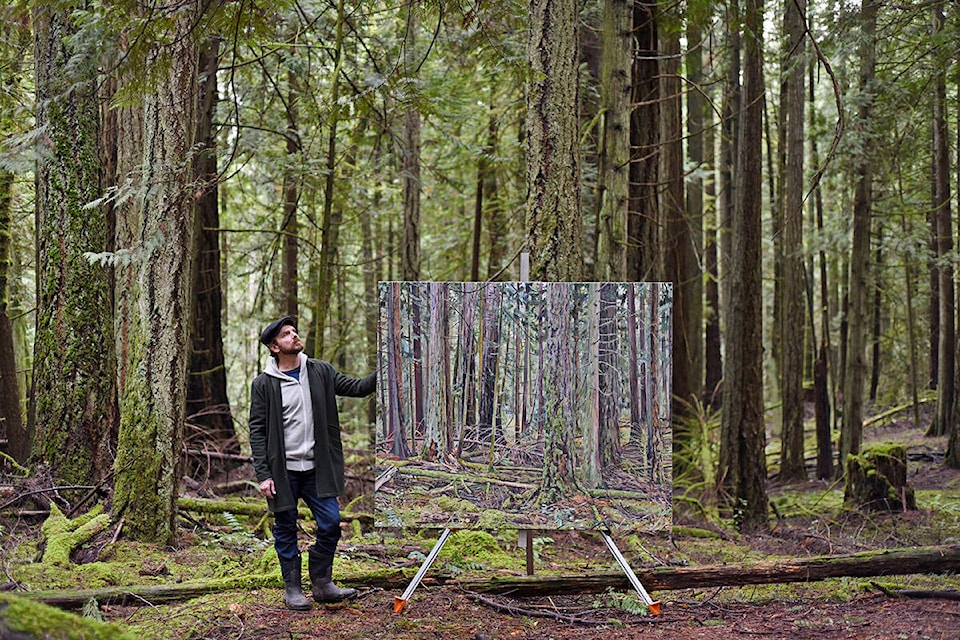- Story by Sean McIntyre Photography by Don Denton
Jeremy Herndl’s final piece of advice before providing the address of his Victoria studio is to dress for the weather. Unusual, perhaps, but not too surprising for someone who specializes in vast oil paintings of primordial forestscapes.
He works out of a nondescript, detached suburban garage behind his home. The space echoes with the song of winter birds floating in from the glade out back, and the cold winter air sinks into the room’s hard concrete floor. Jeremy’s paintings cover the walls, like windows to a lost and changing world. Clad to endure the elements, Jeremy sits at his desk, finishing up a conversation with a supplier about an order of new canvases.
“One day I just have to figure out heating because it’s so uncomfortable here for people,” he says apologetically when he gets off the phone. “I do bundle up when I’m working in here. It’s just like when I’m out there.”
“Out there” is where Jeremy finds inspiration and undertakes the bulk of his artistic work. It is the wooded spaces in and around Victoria, areas where pockets of ancient forest persist within an increasingly developed and industrialized landscape.
Dog walkers, bird watchers and hikers in Saanich’s Francis/King Regional Park or in and around Port Renfrew might have spotted Jeremy at work. Though he may work in isolated spaces, he’s hard to miss.
Jeremy scouts locations by walking into the forest and sketching his surroundings until he lands upon a spot where he feels compelled to settle down. Whereas many artists would then bundle up those sketches and work on them from the comfort of a sheltered and preferably heated studio space, Jeremy goes home to prepare his gear for a return trip to the woods.
“Within a kilometre walk is my limit because it’s a bit of a pain to carry all that stuff,” he says.
Jeremy will retrace his steps to set up his easel, canvas and oils so that he may paint throughout the day and pack things up at dusk, only to repeat the process the following day. The routine will continue for about two weeks, a period in which Jeremy feels he can adequately capture a setting’s changing form and its subtle effect on him as observer and painter.
“I’m out there and I can smell the trees and appreciate the light changes. I learn to really pay attention. In a way I feel like working outside is really special because these places get a chance to express themselves,” he says.
“Because I’m out there for days and days, I start to feel the little changes that happen and realize that maybe it’s not a one-way thing. It becomes a back-and-forth kind of thing. The weather starts to have an effect. It makes the paint thick or it makes the paint thin. Or the rain comes and it makes the paint slip off and stick somewhere else. It’s almost as if the place is participating. I really love the possibility that this process of making a painting feels collaborative.”
Years ago, when he was eight years old, Jeremy’s son looked upon his father’s work as short movies. These seemingly static representations of landscape encompass the continuous play of light, wind, moisture and growth found within each setting.
“I would hope that somebody could appreciate that liveliness,” he says.
In his recent works, Jeremy focuses largely on the natural. This new trail represents a transition from attempts to convey the liminal spaces between the constructed and the natural that have characterized much of Jeremy’s previous work. In his very earliest artistic efforts, undertaken as a young boy who’d moved from an off-grid family cabin near Squamish to downtown Toronto, Jeremy recalls painting many images of trains pointed towards the hills and forests. More recent projects comprise scenes of distant glass-clad condominiums glimpsed through ancient firs and swaying cedars, views that are characteristic of green spaces that endure amidst the built landscape of Vancouver, Surrey and other suburbs of the Lower Mainland.
“Where do we really draw the line? Where does nature end and the human start? Is there such a thing as wilderness or is wilderness something a human could never know because as soon we encounter it, it ceases to be wild?” he asks. “I’ve always wanted to draw that blur, to paint in that blur where humans and wilderness meet because I think it exemplifies the concept that humans are actually nature.
“I think that the old dualist thinking about humans and nature as completely separate has brought us to this situation now, where we find ourselves in such ecological trouble.”
The human element may persist in the guise of his presence as the artist and observer, yet the canvas is now exclusively dedicated to representing Jeremy’s close commune with the forest. It represents an opportunity for creative expression, spiritual fulfillment and existential satisfaction, however fleeting that may be.
“I really want to focus on the forest because it becomes a kind of meditation,” he says. “It’s a very satisfying experience to hear the creatures and the forest and to have a conversation with these places, and then to offer that conversation out to people at this stage, I feel, is an important job.”
People in the Victoria area can glimpse the result of Jeremy’s conversations when his work is presented at Oak Bay’s Winchester Galleries in May and June. Exhibitions are also slated for Calgary, Alta. and London, Ont. later in 2020. Further information about Jeremy’s current projects can be obtained at jeremyherndl.com or on Instagram at @jeremyherndl.
Story courtesy of Boulevard Magazine, a Black Press Media publication
Like Boulevard Magazine on Facebook and follow them on Instagram



